"Introduction to a Distant World"
Mirella Bentivoglio, Simone Fattal, Joel Fisher, Hamish Fulton, Nancy Haynes, Michael Höpfner, Alfredo Jaar, Birgit Jürgenssen, Richard Nonas, Sarah Pichlkostner, Lawrence Weiner

GALERIE HUBERT WINTER
Breite Gasse 17, 1070 Wien Austriatel +43 1 524 09 76 fax + 43 1 524 09 76-9 e-mail:


26. June > 29. August, 2020
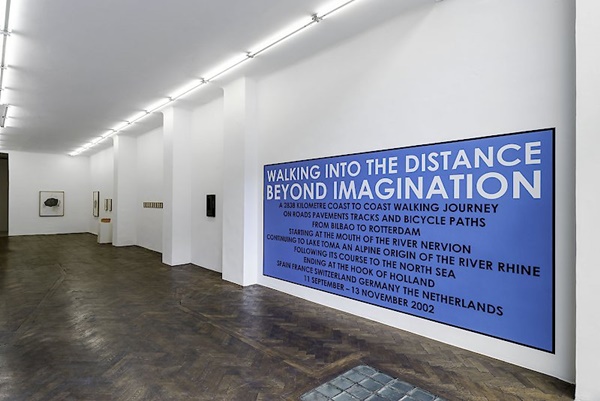
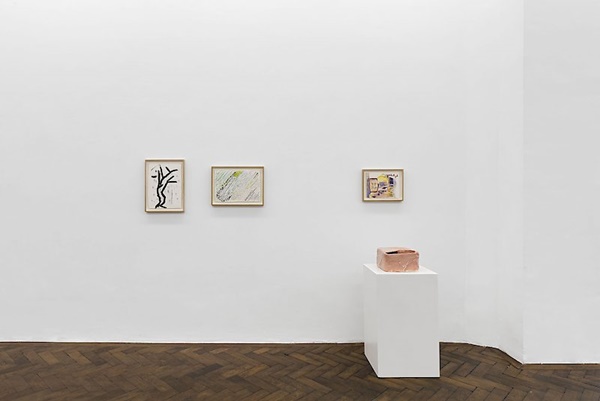
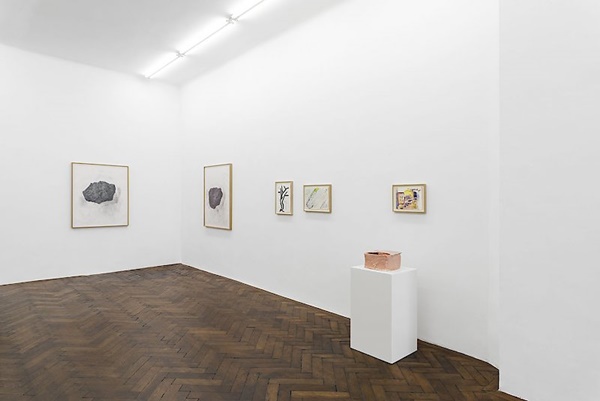
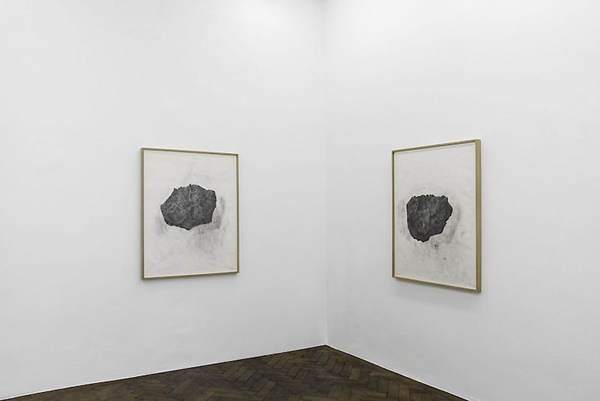
In the descriptive representation of the multitude of human attainments, the unity principle can be conceived most likely under the keyword ‘distance’. An answer to the question ‘how is a human being possible’, could be: by distance.
Hans Blumenberg
The ability to take distance has become a virtue in a time of constant immediacy. This exact ability or freedom of distance was all of sudden severely restricted and became a fundamental behavior of human existence. For many an incision in quotidian life, whereas for some artists distances are fundamental aspects of their artistic practice, e.g. the British artist Hamish Fulton (b. 1946). Walking distances for days and weeks means literally making the experience of distance. Experiencing the latter—not only in the sense of a haul between starting and terminal point, but also in a detached relation to both nature and society—is intrinsic for the walking artist—no walk no art. We (as spectators) can only reconstruct these distances by the enciphered (from our point of view) murals.
Distance does not only mean remoteness but can also exist in close proximity. Taking emotional distance, keeping it or renouncing it at the right time is one of the most difficult decisions you may sometimes have to make. The artist Alfredo Jaar (b. 1956) leads us to this threshold in his video ‘Introduction to a Distant World’ from 1985. Images of workers in a Brazilian gold mine in Serra Pelada depict the intangible conditions of the production of a primary commodity. Jaar’s mise-en-scène makes this distant world disconcertingly accessible and criticizes the modern consumerist society along with its golden nimbus.
Simone Fattal’s (b. 1947) work is very much informed by the distance between historical time and experienced time—thus history and biography. Born in Damascus and raised in Lebanon, Fattal’s ceramics, drawings and watercolors reflect on Lebanese culture, wartime experiences, displacement and construct Fattal’s memories and history in the here and now. Memories are also the lynchpin of Nancy Haynes ‘memory drawings’—events and names of distinguished and inspiring artists are applied to a rigid grid. In her homage to On Kawara Haynes conceptualizes and translates the temporal distance into a spatial one—measured by a ruler. Distance is processed as a metaphor, as temporal distance or parameter—comparable to Joel Fisher’s (b. 1949) ‘From 0 to 9’. John Dewey describes aesthetic distance in 1934 as an intimate attendance and immersing in a perception, a characterization fitting Michael Höpfner’s (b. 1972) newly done drawings—“Distance is a name for a participation so intimate and balanced that no particular impulse acts to make a person withdraw, a completeness of surrender in perception”.1
Sarah Pichlkostner’s (b. 1988) seemingly fragile ‘Moonwalker’ apparently travels distances for us. Contrasting aesthetics and floating states define Pichlkostner’s sculptures, respectively characters. Brittle lines established by technical sophistication and distances emerge as constitutive elements of space.
The notion of distance applies to this exhibition in an interdisciplinary way, detached from its usual contexts. It constitutes a constant reference of all exhibited works. Linguistic shifts, concrete poetry and instructions are found in the works of Mirella Bentivoglio (1922–2017), Richard Nonas (b. 1936) and Lawrence Weiner (b. 1942). Not distanced, but distance in form of restraint is a pivotal element of Birgit Jürgenssen’s (1949–2003) artistic practice. Photographs—covered with gauze—become veiled for the spectator. Jürgenssen thus deliberately produces an exceptional, tactile temptation, sensual aesthetics and fantastic sequences of images.
1 John Dewey, Art as Experience (1934), New York 1958, S. 258
The ability to take distance has become a virtue in a time of constant immediacy. This exact ability or freedom of distance was all of sudden severely restricted and became a fundamental behavior of human existence. For many an incision in quotidian life, whereas for some artists distances are fundamental aspects of their artistic practice, e.g. the British artist Hamish Fulton (b. 1946). Walking distances for days and weeks means literally making the experience of distance. Experiencing the latter—not only in the sense of a haul between starting and terminal point, but also in a detached relation to both nature and society—is intrinsic for the walking artist—no walk no art. We (as spectators) can only reconstruct these distances by the enciphered (from our point of view) murals.
Distance does not only mean remoteness but can also exist in close proximity. Taking emotional distance, keeping it or renouncing it at the right time is one of the most difficult decisions you may sometimes have to make. The artist Alfredo Jaar (b. 1956) leads us to this threshold in his video ‘Introduction to a Distant World’ from 1985. Images of workers in a Brazilian gold mine in Serra Pelada depict the intangible conditions of the production of a primary commodity. Jaar’s mise-en-scène makes this distant world disconcertingly accessible and criticizes the modern consumerist society along with its golden nimbus.
Simone Fattal’s (b. 1947) work is very much informed by the distance between historical time and experienced time—thus history and biography. Born in Damascus and raised in Lebanon, Fattal’s ceramics, drawings and watercolors reflect on Lebanese culture, wartime experiences, displacement and construct Fattal’s memories and history in the here and now. Memories are also the lynchpin of Nancy Haynes ‘memory drawings’—events and names of distinguished and inspiring artists are applied to a rigid grid. In her homage to On Kawara Haynes conceptualizes and translates the temporal distance into a spatial one—measured by a ruler. Distance is processed as a metaphor, as temporal distance or parameter—comparable to Joel Fisher’s (b. 1949) ‘From 0 to 9’. John Dewey describes aesthetic distance in 1934 as an intimate attendance and immersing in a perception, a characterization fitting Michael Höpfner’s (b. 1972) newly done drawings—“Distance is a name for a participation so intimate and balanced that no particular impulse acts to make a person withdraw, a completeness of surrender in perception”.1
Sarah Pichlkostner’s (b. 1988) seemingly fragile ‘Moonwalker’ apparently travels distances for us. Contrasting aesthetics and floating states define Pichlkostner’s sculptures, respectively characters. Brittle lines established by technical sophistication and distances emerge as constitutive elements of space.
The notion of distance applies to this exhibition in an interdisciplinary way, detached from its usual contexts. It constitutes a constant reference of all exhibited works. Linguistic shifts, concrete poetry and instructions are found in the works of Mirella Bentivoglio (1922–2017), Richard Nonas (b. 1936) and Lawrence Weiner (b. 1942). Not distanced, but distance in form of restraint is a pivotal element of Birgit Jürgenssen’s (1949–2003) artistic practice. Photographs—covered with gauze—become veiled for the spectator. Jürgenssen thus deliberately produces an exceptional, tactile temptation, sensual aesthetics and fantastic sequences of images.
1 John Dewey, Art as Experience (1934), New York 1958, S. 258
 |
Mirella Bentivoglio |
 |
Simone Fattal |
 |
Joel Fisher |
 |
Hamish Fulton |
 |
Nancy Haynes |
 |
Michael Höpfner |
 |
Alfredo Jaar |
 |
Birgit Jürgenssen |
 |
Richard Nonas |
 |
Sarah Pichlkostner |
 |
Lawrence Weiner |
OPENING reception :
Opening reception on June 25 2020, 7–9pm.
Opening reception on June 25 2020, 7–9pm.
mpefm
AUSTRIA art press release
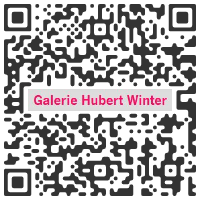
QR of this press release
in your phone, tablet








